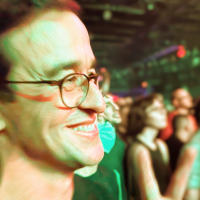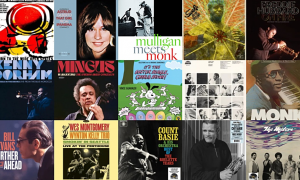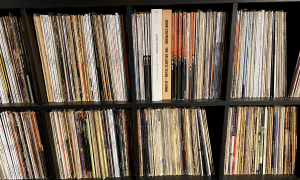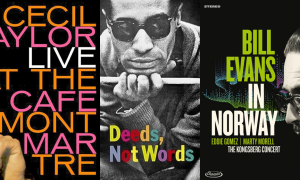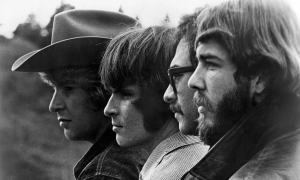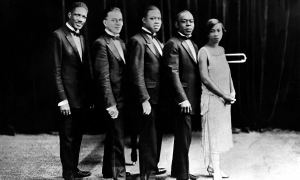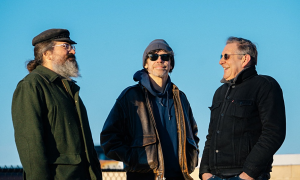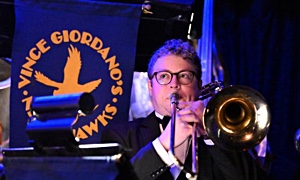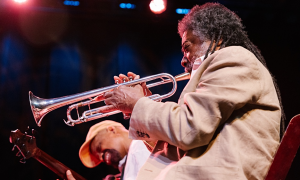Home » Jazz Articles » Journey into Jazz » Big Ears 2025: A Personal Perspective
Big Ears 2025: A Personal Perspective

My Big Ears is a somatic extravaganza, a yearly pilgrimage that feels necessary and renewing: the Monday following the fest is akin to my January 1st. An oasis away from the breaking news and flash briefings, the gathering is cerebrally hedonistic and yet inherently subversive. Big Ears brings big ideas to the rural south, where each attendee's path carves through genres with scant regard for convention and compliance. While I never heard direct mention of the current regime from the stage, the concepts offered during could well-nigh promulgate a revolution.
Why? Because Big Ears' balm can be seen in direct relation to the emerging focus on the vagus nerve and intergenerational trauma. If our traumas can be genetically passed down, it stands to reason that healing—or the experiential and incremental minimization of that trauma—can be found here. Its cures are multiple and encompass the realms of art and somatic therapy. This regime wants us to be disconnected from ourselves and each other; Big Ears conversely offers liberation through multiple means, reaching from the individual to the collective.
Though I had only scheduled the first few parts of the Philip Glass Ensemble's Music in 12 Parts, my body was drawn to stay for the entirety of Friday, and to return on Saturday. With eyes closed, the sounds evolved from my head as technical musicianship into a body-driven release that extended well beyond my seat in the Tennessee Theater. I quivered, I shook. Upon the Ensemble's final bow, I surprised myself with tears of gratitude, stunned with appreciation of the devotion required to offer such healing.
And what is a body to do in response to an hour of أحمد Ahmed's fierce free jazz? Stamina is a prerequisite, as the four-piece offer a potent combination of static and ever-escalating tones and zones that prompt the listener's internal voice to ponder the band's ability to maintain such intensity. That voice soon shhhhes, as it becomes quickly obvious that higher, deeper into, and beyond is the nature of this experience. There's not even space to applaud after certain moments of band serendipity; it is sustained serendipity. A body cannot leave the venue identical to the pre-show you: "thank you so much, I forgave everybody" is what my friend offered to the band while passing on the street later.
Broadening now to this music's service in the collective realm, I recall Canzoniere Grecanico Salentino's description of the historical purpose of the tarantellas comprising the band's speciality. Musicians traditionally offered a curative circle in response to a tarantula bite's poison, because "when you breathe and when you vibe together, along with the power of music and dance, you can split that suffering into many smaller pieces and multiply the joy. If you dance alone, you cannot heal." Also acknowledging the current poisons of isolation, fear, and war, the seven-piece Italian ensemble employed frame drums, bouzouki, violin, accordion, and a dancer to weave a sustaining spell in a rapt Mill and Mine.
This type of healing echoes Collective Effervescence, a Durkheimian concept from which a recent University of Tennessee dissertation concluded that Big Ears served to "[unite attendees] in a space characterized by pride, hope, and gratitude" and that "the effervescent nature of the festival revitalized the attendees, elicited positive emotions, or both." Revisiting the student's notes from my 2023 interview, he captured my belief that the gathering "restores my faith in humanity, recenters the purpose of art in my life, makes me realize that these ideas need support because they can change the status quo and the thinking that got us into our current mess. Art provides alternatives to the dominant paradigm, and Big Ears refreshes my brain, reminding me that there are a lot of reasons to be hopeful."
This effervescence is of course found in raves and jam band experiences, but I find the inclusive nature of Big Ears artist curation to have its own rejuvenating logic. A smattering of this year's pieces and themes included: Gardens of Peace in Five Parts; Collective Offerings of Sound, Light & Architecture, Molten Soundscapes: Freeform Glass & Sonic Sculpture; Revolutionary Fire-Love; Free Form Funky Freqs; and No More Water—The Gospel of James Baldwin. Even without a deeper knowledge of the global breadth of artistry, simply scrolling this year's lineup makes obvious that Big Ears is sonic, experiential DEI. This unity in diversity delightfully stuns the separation-and-division logic that this regime uses to slur, dismiss, and erode.
Presence is a prerequisite: a playlist just doesn't have the same punch. Believers put themselves in Knoxville's rooms to experience deep zones: my body pounded in parallel but unique ways for BEAK>, DARKSIDE, and Explosions in the Sky. Participants find surreal late-night moments, as 13-piece Water Damage swirls out a maelstrom of thud and strum, or Evicshen brandishes a whip and contact-mic'd record-saw contraption within a turntable noise trio. It is possible to intellectualize unique personalities as trios manifest in tripartite musical agreements: Dan Weiss, Kris Davis, and Luke Stewart titling three of the unique five performing. And prior attendees weren't surprised to find specialists in prepared piano, solo trombone, Scottish bagpipes, and an Ukrainian "ethno chaos" band competing for attention on their 2025 schedules.
With so much of interest simultaneously happening for a curious mind, FOMO is a deeply-felt fear. A comforting friend offered me "there are no bad choices" at Big Ears. That helps, as does listening more internally: just as my body was inexplicably drawn to the duration of Music in 12 Parts, I found myself taking more integration breaks (I saw 29 acts, down from last year's 35). Through expanding attention to where I sit versus what I'm missing, my 2025 mantra was "the best thing happening is where I am." Presence and immersion enhance a Big Ears experience; I pondered if this year's buggy app was an intentional organizer ploy to keep folks off devices and towards their paper schedules.
Connecting real-life conversations are commonplace at Big Ears. Though I'm useless at big-screened sports bars, waiting for shows while discussing jazz lesser-knowns or who's collaborating where within International Anthem Recording Company's roster offers my heart the same solace those orange-clad Volunteer fans embrace. I have long-time friends that I only see in Knoxville, and happily reunion with fan-friends that I made there: we're all on this journey together. Moreover, there's a hopefulness I carry that a Big Ears first-timer tagging along for recent years' indie rock or Americana headliners will unknowingly step into a jazz, New Music, or 'challenging' performance and have their trajectory altered.
As the festival wound down Sunday evening, the solo saxophone of Josh Johnson built percussive, airy, and looped sound worlds pointing towards the horizon and beyond. Prefacing a between-song break with a James Baldwin quote, Johnson pondered that we are living in a "tense moment, and I think experiences like this—communing with one another, attentive listening—are all things to celebrate, and for us to do more of. Every person deserves security of both mind and body." Considering Maslow's pyramid, Big Ears' gifts escalate well-beyond that baseline of security: writing this in the days after, I retained a sense of fulfilment.
Akin to how travel broadens the mind, Big Ears offers each attendee a voyage that can heal in a manner atypical of what is associated with the word "festival," particularly as a contrasting respite in an increasingly diminishing and dysfunctional country. With each event, the illusion of separation falls away: the borders and walls of genre and nationality can be seen as delusions to the human experience. Through Big Ears' expansive interpretation, curiosity succeeds over judgement, inclusion triumphs over division. And in so doing, I am gratefully, sustainedly renewed.
Tags
Live Review
Mark Adams
United States
Philip Glass
Ahmed
Canzoniere Grecanico Salentino}
James Baldwin
BEAK>
Darkside
Explosions in the Sky
Water Damage
Evicshen
Dan Weiss
Kris Davis
Luke Stewart
Josh Johnson
Comments
PREVIOUS / NEXT
Support All About Jazz
 All About Jazz has been a pillar of jazz since 1995, championing it as an art form and, more importantly, supporting the musicians who make it. Our enduring commitment has made "AAJ" one of the most culturally important websites of its kind, read by hundreds of thousands of fans, musicians and industry figures every month.
All About Jazz has been a pillar of jazz since 1995, championing it as an art form and, more importantly, supporting the musicians who make it. Our enduring commitment has made "AAJ" one of the most culturally important websites of its kind, read by hundreds of thousands of fans, musicians and industry figures every month.

